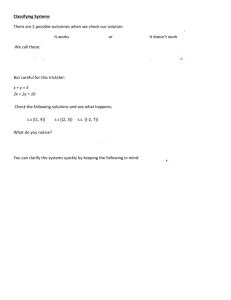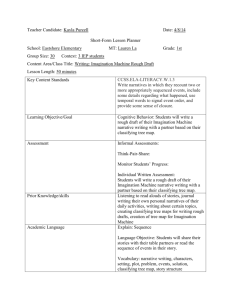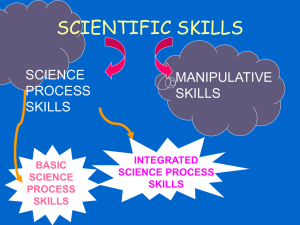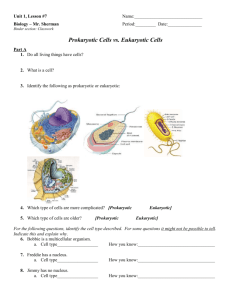Classifying Objects 5E
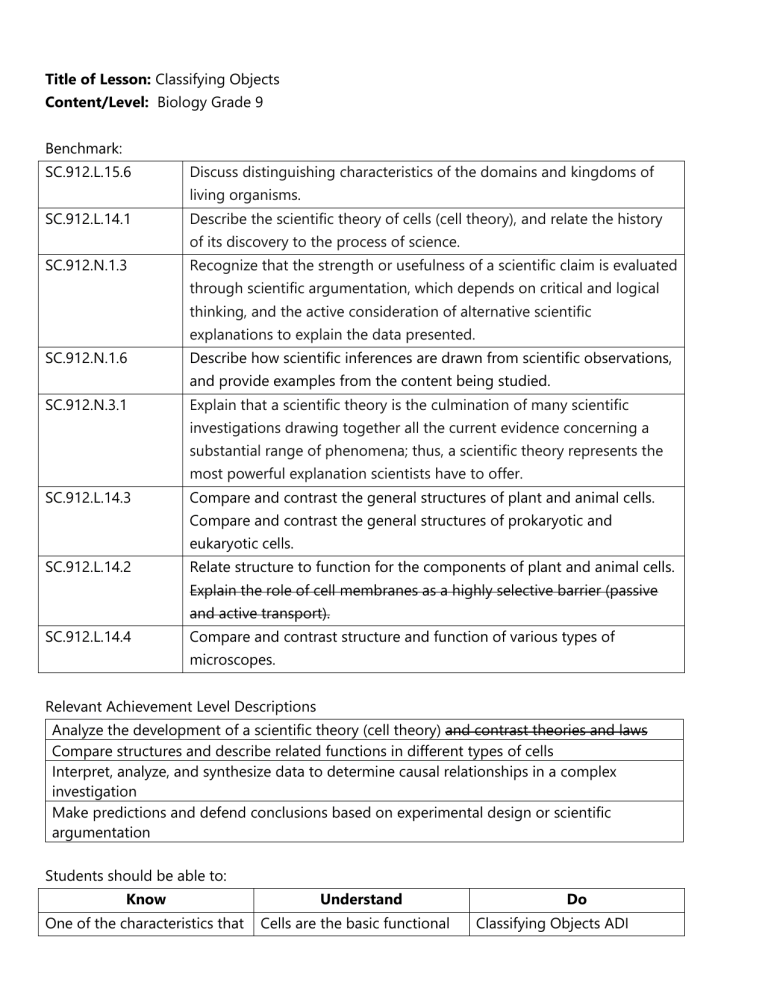
Title of Lesson: Classifying Objects
Content/Level: Biology Grade 9
Benchmark:
SC.912.L.15.6 Discuss distinguishing characteristics of the domains and kingdoms of living organisms.
SC.912.L.14.1 Describe the scientific theory of cells (cell theory), and relate the history of its discovery to the process of science.
SC.912.N.1.3 Recognize that the strength or usefulness of a scientific claim is evaluated through scientific argumentation, which depends on critical and logical thinking, and the active consideration of alternative scientific explanations to explain the data presented.
SC.912.N.1.6
SC.912.N.3.1
SC.912.L.14.3
Describe how scientific inferences are drawn from scientific observations, and provide examples from the content being studied.
Explain that a scientific theory is the culmination of many scientific investigations drawing together all the current evidence concerning a substantial range of phenomena; thus, a scientific theory represents the most powerful explanation scientists have to offer.
Compare and contrast the general structures of plant and animal cells.
Compare and contrast the general structures of prokaryotic and eukaryotic cells.
SC.912.L.14.2 Relate structure to function for the components of plant and animal cells.
Explain the role of cell membranes as a highly selective barrier (passive and active transport).
Compare and contrast structure and function of various types of SC.912.L.14.4 microscopes.
Relevant Achievement Level Descriptions
Analyze the development of a scientific theory (cell theory) and contrast theories and laws
Compare structures and describe related functions in different types of cells
Interpret, analyze, and synthesize data to determine causal relationships in a complex investigation
Make predictions and defend conclusions based on experimental design or scientific argumentation
Students should be able to:
Know Understand Do
One of the characteristics that Cells are the basic functional Classifying Objects ADI
differentiate nonliving things from living things is the presence of cells.
The cell theory describes how current science understands cells.
Cells are classified as prokaryotic or eukaryotic.
Plant and animal cells are examples of eukaryotic cells. unit of living things.
The cell theory states: (a) all living things are composed of cells, and living things may be unicellular or multicellular, (b) the cell is the basic unit of life, and (c) all cells arise from preexisting cells.
Prokaryotic cells lack a true nucleus and membranebound organelles
Eukaryotic cells have a true nucleus and membranebound organelles.
Plant cells have large vacuoles, a cell wall, and chloroplasts, whereas animal cells do not.
Animal cells have lysosomes, whereas plant cells do not.
Classifying Objects ADI
Classifying Objects ADI
JIT Teaching
Classifying Objects ADI
JIT Teaching
Text References:
N/A
Electronic References
Electronic Attachments
TedEd—The Wacky History of Cell Theory http://ed.ted.com/lessons/the-wacky-history-of-cell-theory https://www.youtube.com/watch?v=4OpBylwH9DU
Amoeba Sisters: Prokaryotes & Eukaryotes https://www.youtube.com/watch?v=ruBAHiij4EA
Flinn Scientific Pogil: Prokaryotic vs. Eukaryotic Cells https://www.flinnsci.com/.../pogil_prokaryotic_and_eukaryotic_cells.pdf
The Wacky History of Cell Theory Graphic Organizer
Classifying Objects ADI Investigation
Classifying Objects Characteristics Table
Classifying Objects Sorting Cards
Classifying Objects Data Table (Optional)
Classifying Objects Paper Whiteboard Template
Days 1 & 2
Objective Students will learn the three tenets of the cell theory and determine how the cell theory was developed and has changed over time through watching a TedEd video clip, “The Wacky History of Cell Theory” and completing a graphic organizer.
(SC.912.L.14.1 and SC.912.N.3.1)
Students will complete an ADI investigation and analyze a data table of objects found on Earth to determine the distinguishing characteristics of (a) living vs. nonliving things, (b) prokaryotic vs. eukaryotic cells, and (c) features unique to the different groups of eukaryotes to answer the guiding question, “Which objects in the table are classified as animals and why?” (SC.912.L.14.3, SC.912.N.1.3, SC.912.N.1.6, and
SC.912.L.15.6)
Essential
Learning
Materials
Students will learn the three tenets of cell theory.
Students will learn characteristics that distinguish:
(a) living from nonliving things
(b) prokaryotic from eukaryotic cells
(c) plants from animals from other eukaryotes (fungi and protists)
Computer with Internet Connection
LCD Projector
The Wacky History of Cell Theory Graphic Organizer
Classifying Objects ADI Investigation
Classifying Objects Characteristics Table
Classifying Objects Sorting Cards
Classifying Objects Data Table (Optional)
Classifying Objects Paper Whiteboard Template
Cell Structure: Prokaryotes & Eukaryotes WS
Prokaryotic & Eukaryotic Cells POGIL WS
Organelles in Eukaryotic Cells POGIL WS
Prokaryotes vs. Eukaryotes WebQuest, Venn Diagram, & Table
Cell Structure Gizmo & Student Exploration Sheet
The Cell as a School WS
Cell Foldable
Pacing Two class periods (approximately 100 minutes)
Advanced Prep:
Xerox and provide each student with a copy of:
(a) The Wacky History of Cell Theory Graphic Organizer
(b) Classifying Objects ADI Investigation
(c) Classifying Objects Characteristics Table
(d) Classifying Objects Data Table (Optional)
(e) Classifying Objects Paper Whiteboard Template
Prepare a set of Classifying Objects Sorting Cards for each group of students (3-4 students)
ENGAGE:
1.
Show the TedEd video clip, “The Wacky History of Cell Theory.” Two links to the video have been provided below.
(a) http://ed.ted.com/lessons/the-wacky-history-of-cell-theory
(b) https://www.youtube.com/watch?v=4OpBylwH9DU
2.
Students should complete “The Wacky History of Cell Theory” graphic organizer.
EXPLORE:
3.
Provide each student with a copies of (a) Classifying Objects ADI Investigation, (b) Classifying
Objects Characteristics Table, (c) Classifying Objects Data Table and (c) Classifying Objects
Paper Whiteboard Template.
4.
Introduce the guiding question, “Which objects in the table are classified as animals and why?
5.
Read the Introduction/Background Information provided on the Classifying Objects ADI
Investigation handout and review the task.
6.
If desired, provide groups of students with the Classifying Objects Sorting Cards and individual
students a copy of the Classifying Objects Data Table to assist with the organization and analysis of data.
7.
Student groups should analyze the Classifying Objects Characteristics Table (and possibly the
Classifying Objects Data Table and Classifying Objects Sorting Cards) to determine which objects should be classified as animals in order to construct their paper whiteboard, indicating their claim, evidence, and justification on the template provided. Instruct students that they will need this completed paper template the following day in class when they construct their actual whiteboard in preparation for carousel review. (Note: The purpose of constructing a paper whiteboard is that we have found there is not enough instructional time in a 50-minute class period to analyze the data, construct a whiteboard, and complete a sufficient carousel review and discussion.)
8.
Students should refine their claim, evidence, and justification on their paper whiteboard template for homework.
Day 3 a and
Objective Students will communicate their claim, evidence, and justification to other student researchers using a carousel review. (SC.912.N.1.3 and SC.912.N.1.6)
Essential
Learning
Students will provide evidence and justification to show that the dog and sponge should be classified as animals and how they eliminated all of the other objects in the table.
Materials Completed Classifying Objects Whiteboard Template (from Day 1)
ADI Whiteboards
Portable Tripods (to display whiteboards)
Dry Erase Markers
Erasers
Pacing One class period (approximately 50 minutes)
Advanced Prep:
Ensure you have a whiteboard set (whiteboard, tripod, dry erase markers, and eraser) for each group of 3-4 students.
ELABORATE/EXTEND: (50 minutes)
1.
Have student groups convene to discuss any overnight additions/refinements to their paper whiteboard templates (5 minutes)
2.
Have students transfer the information on their paper whiteboard to their actual whiteboard.
Students will take forever embellishing, so we recommend that this be a timed activity. (15 minutes)
3.
Explain the carousel review process to students, indicating each round will last five minutes.
See diagram below. (5 minutes)
4.
Conduct a minimum of three rounds of carousel review to allow students to view multiple perspectives. (15 minutes)
5.
Allow students to reconvene with their home group to discuss what they learned from other groups and to consider possible changes to their paper whiteboards. (10 minutes)
Day 4
Objective Students will compare and contrast the general structure and function of (a) prokaryotic vs. eukaryotic cells and (b) plant cells vs. animal cells through the teacher’s choice of resource(s) from the Just in Time Teaching folder. (SC.912.L.14.2 and SC.912.L.14.3)
Resources include:
Cell Structure: Prokaryotes & Eukaryotes WS
Prokaryotic & Eukaryotic Cells POGIL WS
Organelles in Eukaryotic Cells POGIL WS
Prokaryotes vs. Eukaryotes WebQuest, Venn Diagram, & Table
Cell Structure Gizmo & Student Exploration Sheet
The Cell as a School WS
Cell Foldable
Essential
Learning
This serves a JIT teaching piece to solidify student understanding of the distinguishing features of (a) prokaryotic and eukaryotic cells and (b) plant and animal cells. Students also will demonstrate understanding of the functions of cellular organelles.
Materials Computer with Internet Connection
LCD Projector
JIT (Teacher Choice) WS
Pacing One class period (approximately 50 minutes)
Advanced Prep:
Review the materials in the Just in Time Teaching Folder. Choose the resource(s) that best fit your students’ needs and your teaching style.
EXPLAIN:
1.
Implement your chosen JIT resource to ensure students understand the features that distinguish prokaryotic and eukaryotic cells, plant and animal cells, and the general functions of these features.
Day 5
Objective Students will compare and contrast images of Euglena captured from a compound light microscope, a scanning electron microscope, and transmission electron microscope to understand the applications and functions of various microscopes.
(SC.912.L.14.4)
Students will synthesize learning from the Classifying Objects ADI and Just in Time
Teaching to classify Euglena as (a) living or nonliving, (b) prokaryotic or eukaryotic, and (c) plant, animal, or other
Essential
Learning
Students will be able to identify the functions of the different types of microscopes and the types of images they produce.
Students will use previous learning and the characteristics table provided to distinguish Euglena as: (a) living, (b) eukaryotic, (c) neither plant nor animal. (In fact:
Euglena is a protist.
Materials What is a Euglena WS
Biology Textbook
Pacing One class period (approximately 50 minutes)
Advanced Prep:
Xerox and provide each student with a copy of the worksheet, “What is a Euglena?”
EXTEND/ELABORATE
1. Have students complete the worksheet, “What is a Euglena” to review the functions of various microscopes and to apply their learning from the Classifying Objects ADI and JIT Teaching in a different context.
Day 64&
Objective Students will respond to an LDC Writing Task as a summative measure of their learning.
The writing task is:
After researching informational text, completing ADI scientific investigations on classifying objects, and participating in JIT teaching, write an essay that discusses the cell theory and evaluates how you can distinguish the following: (a) a virus from living things, (b) a prokaryote from a eukaryote and (c) eukaryotes representing different biological kingdoms (plant, animal, fungi, and protist). Be sure to support your position with evidence from your research.
Materials Cells Part I Summative Assessment (LDC Writing Task)
Pacing One class period (approximately 50 minutes)
Advanced Prep:
Xerox and provide each student with a copy of Cells Part I Summative Assessment (LDC Writing
Task)
EVALUATE:
1.
Students should synthesize information learned in this lesson to compose an essay that addresses the LDC writing task.
